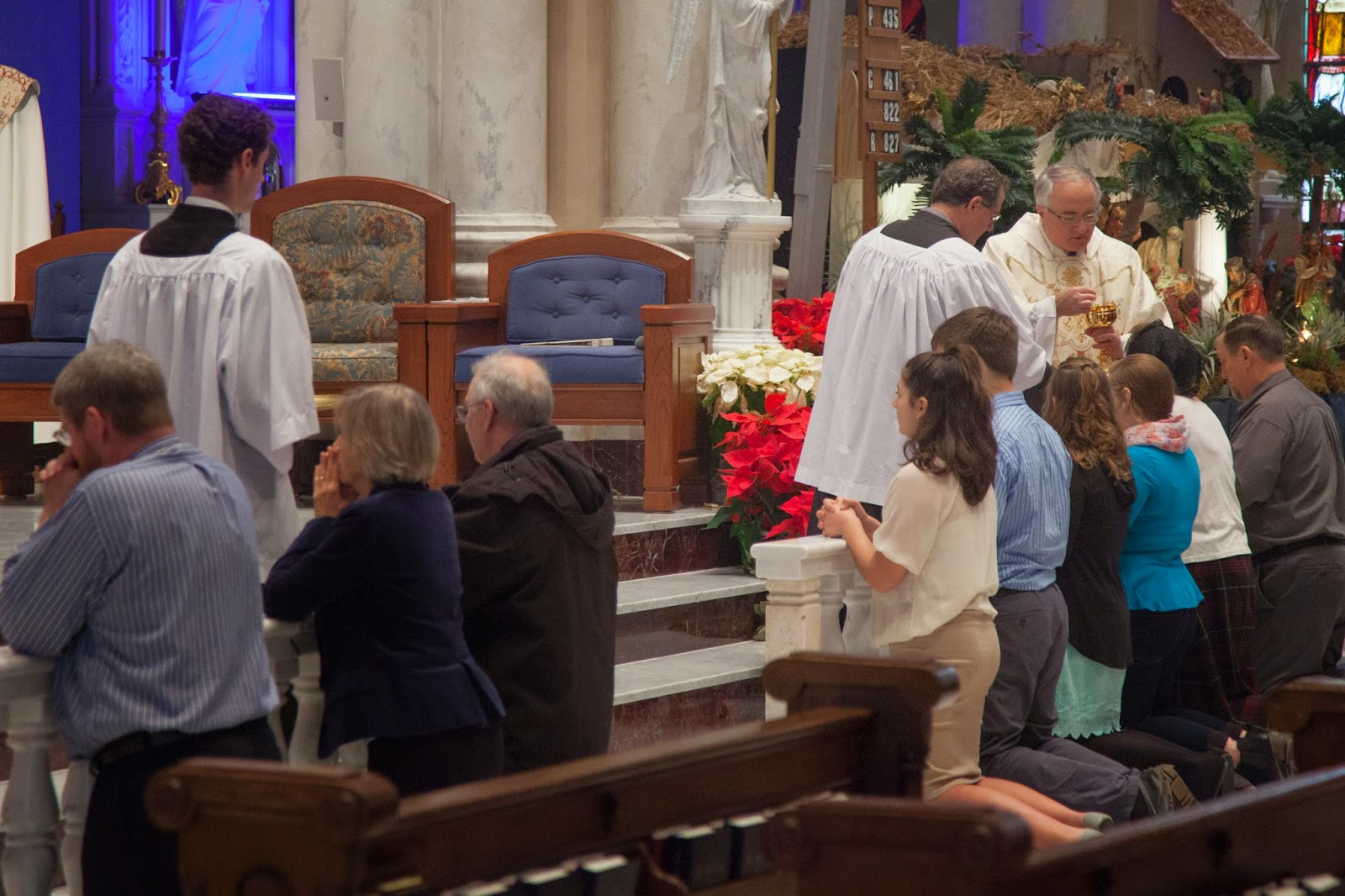
The faithful kneeling at the altar rail during the distribution of Holy Communion.
The Communion rail is known by different names, but my favorite is the “altar of the faithful.” You will notice during Mass in the Extraordinary Form how the priest leans his forearms on the altar during the consecration of the Body and Blood of Christ. The altar is a symbol of Christ, especially his strength. Therefore, the priest in that small sign shows that he is relying on the strength of Christ rather than his own worthiness. Again when he makes his Communion, he leans on the altar in the same way and for the same reason. Traditionally fashioned out of marble and cut to match the altar—we are blessed to have that traditional rendering of the altar and rail—, the faithful offer themselves to the heavenly Father as Christ offers himself on the altar. The faithful who choose to kneel at the rail lean on it, a symbol of the strength of Christ who stands firmly to support a weak people. Upon the altar rail, the “people’s altar,” the faithful daily make their offering of themselves to the heavenly Father. Each in their own way and proper to their own vocation (Lumen gentium, 11), then, show forth the full offering of the Body of Christ.
The altar rail, with it’s gates, is symbolic of our final end, the heavenly gates. In the construction of churches, Catholic architects always made a firm delineation between the nave and the sanctuary, since the sanctuary represents the heavenly realm. Without a gate, or a doorway into a dwelling place, it is impossible to know where one is headed. A door gives us a direction, a point for which to set out on our pilgrim journey. If the nave represents the earthly realm and the sanctuary represents the heavenly realm, the altar rail is the edge of heaven. The Mass is truly “the most beautiful thing this side of heaven” (John Henry Cardinal Newman), and the Mass is directly connected to the eternal offering that Christ makes in heaven to his Eternal Father. Receiving at the rail allows us to draw close to heaven. “But you are come to mount Sion, and to the city of the living God, the heavenly Jerusalem, and to the company of many thousands of angels. And to the church of the firstborn, who are written in the heavens, and to God the judge of all, and to the spirits of the just made perfect, and to Jesus the mediator of the new testament, and to the sprinkling of blood [that is, the celebration of the new covenant] which speaketh better than that of Abel” (Hebrews 12:22-24).
The altar rail gives each individual a greater time for recollection. Rather than waiting in line for each to have their turn, we have a moment to move to the rail and recollect ourselves. Christ gives Himself to us as Food for our pilgrim journey to God. It not only is a nourishment in our weakness, but a medicine for our spiritual ills. It is Christ who “passes by” at the rail when the priest distributes Communion. The faithful have a precious moment to wait at the rail along Jesus’ way, like the blind man of Jericho who stopped Christ along his way by crying out, “Jesus, Son of David, have mercy on me a sinner” (cf. Luke 18:35-38). A practical aspect of having more time to prepare oneself affects elderly parishioners. Many older members of the congregation would like to kneel, but it takes them some time to get down and then get back up; and when we are only using one spot at the rail for the parishioners who desire to kneel, others have to wait. By using the full length of the rail, parishioners who have trouble going to kneel and getting up from kneeling have more time to get situated at the rail.
The altar rail gives a logical, repetitive order to the distribution of Communion. For children, the order and sobriety of the altar rail’s use helps to keep their attention fixed, even if they are too young to understand fully what is happening. Rather than being “herded” forward by a parent or an older sibling, the child actually accompanies his/her family to the altar of God. At the same time, the order that is visibly present when Communion is distributed at the rail is an expression of the nature of Communion. Rather than being an individual act, the faithful line up at the rail side-by-side and show forth their community through reception of Communion, which strengthens those bonds of charity. Even if someone doesn’t know the person on his right or left, he is part of the same Body.
Lastly, three practical aspects must be mentioned. First of all, two distributing Communion at the rail is quicker than many “Communion stations.” Since the faithful are lined up and ready to receive at the rail, the time it takes to Communicate the faithful is shortened. Secondly, the possibility of any type of profanation of the Blessed Sacrament is greatly reduced if not nearly eliminated. Ushers will no longer be required to “stand guard” on the wings to encounter anyone who might not have consumed a host. Thirdly, using the altar rail, whether the faithful choose to kneel or stand, preserves an ancient and lasting tradition of the Church while still respecting the current permission in the United States to receive Communion in the hand while standing.